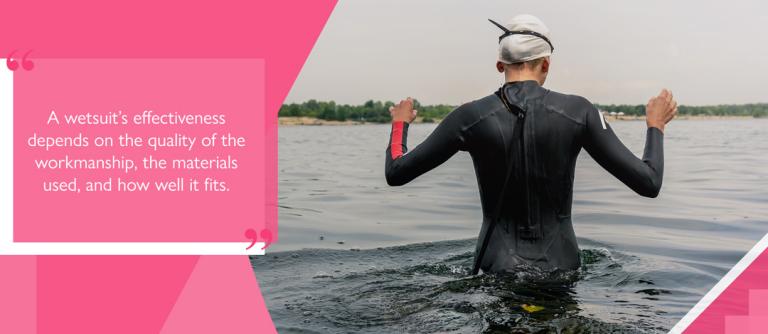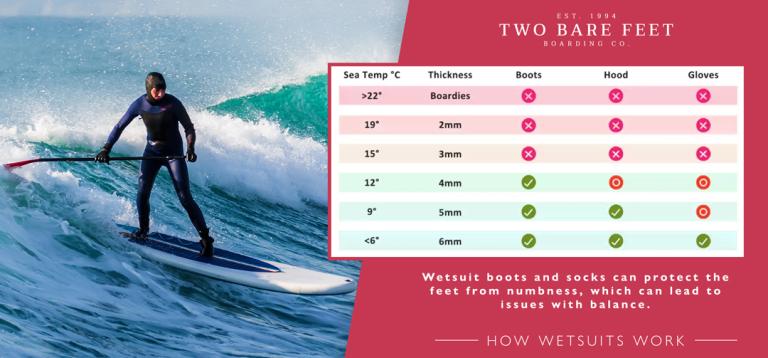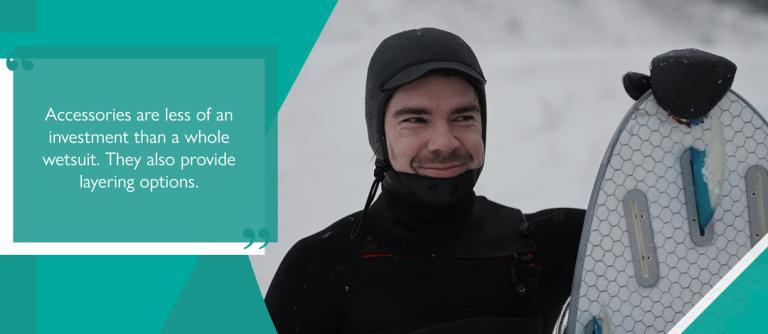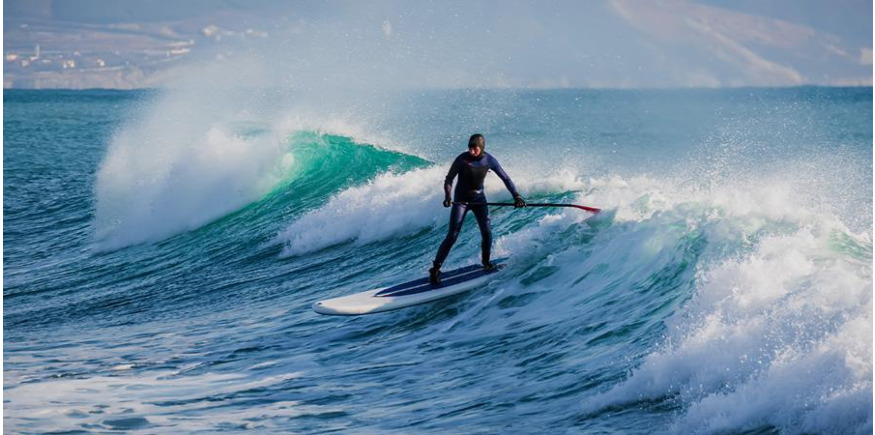If you’re wondering what wetsuit to buy for which conditions, it can be a balance. The thicker the wetsuit, the warmer it will be. However, thicker wetsuits can impair movement and flexibility.
How do wetsuits work?
A layer of water is trapped under the surface of the wetsuit, where it is warmed by body heat. This creates an insulating barrier.
The neoprene material used in wetsuit construction contains air pockets which provide additional insulation. Thicker neoprene offers better heat conservation.
How effective a wetsuit is will depend on the quality of the suit’s workmanship, the materials used, and how well it fits the individual. A loose-fitting wetsuit will retain water less well , negating the insulating action provided by the barrier of water.

What wetsuit thickness is best?
This will depend mostly on the activity the wearer is partaking in, how much flexibility is needed and how cold conditions are. Quality wetsuits will utilise techniques and materials that insulate better with less restriction.
Two (sometimes three) numbers are used to denote wetsuit thickness in retailer’s descriptions, e.g. 4/3/3. These figures reflect the amount of insulating material (in millimetres) used in the torso panels, then the legs, and finally the arms.
Thick torso panels keep core body temperature up. Thinner panels on the limbs offer increased mobility for arms and legs.
Wetsuit thicknesses
2mm wetsuit
A wetsuit of this thickness is often considered a summer option. 2mm wetsuits can be warm enough in cool temperatures, while undertaking a high intensity sport, or if supplemented with accessories, such as hoods or thermal wetsuit underlayers .
3mm wetsuit
For spring or autumn days when the wind is up, a 4/3 or completely 3mm wetsuit will provide decent insulation. 3mm-thick neoprene won’t restrict movement in arms or legs, but it will keep the wearer warmer than a 2mm wetsuit would.
5mm wetsuit
Once water temperatures drop below 10°C, a 5mm wetsuit is recommended. This could be 5mm in the torso panels, but potentially thinner over the limbs to allow more flexibility.
If you intend to be underwater for extended periods, or there are strong winds, wetsuit hoods can prevent further heat loss and protect from surfer’s ear: a painful condition caused by repeated exposure to cold winds and water.
It’s also recommended to wear wetsuit boots or socks to protect from cold water lapping at the board. This can quickly sap heat and lead to balance issues, should feet or ankles become numb. This also has the potential to cause painful chilblains.

Thicker wetsuits
Water at 6°C or lower may require 6mm or even 7mm wetsuits to protect from extreme cold. It’s inadvisable to go without a wetsuit hood in these temperatures.
Thick arctic wetsuits (6mm and above) are becoming less common, as material technology improves. Thinner wetsuits are increasingly able to deliver effective insulating performance without stifling the wearer or reducing their movement.
Wetsuit types
Material thickness isn’t the only factor that affects wetsuit warmth. Style, accessories and manufacturing all influence effectiveness against cold temperatures.
The best wetsuit for open water swimming will differ from the best for kayaking or paddleboarding. This is down to differences in the amount of time spent in the water versus the types of physical activities and their durations.
Those with smaller budgets or restricted storage may not have the option for multiple wetsuits of varying thickness. Wetsuit accessories are less of an investment and provide the option to remove or add layers out on the water, should weather conditions change.
Wetsuit seams
Seams can make or break a winter wetsuit. Well-sealed seams will prevent water from being flushed through the suit, reducing its insulating potential. Neoprene tape seals are the most effective. Glued- and blind-stitched seals are more common, but are also effective and comfortable.

When paddleboarding in winter , always respect the elements and dress to the conditions. While you may not intend to spend much time in the water, you should be prepared for all eventualities.
Equipment warm enough for daytime sun and light wind may not hold up in adverse weather or if you become stranded in cold water. Well-made winter wetsuits can be your lifeline and help avoid hypothermia.
For wetsuits you can trust, browse the full range of winter wetsuits available on our website .




